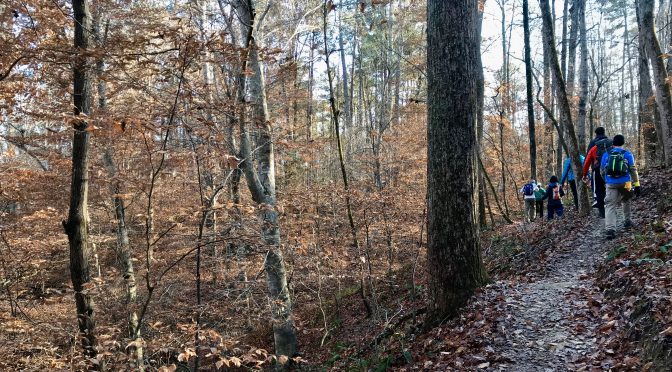A crisp, brilliant day without a cloud in the sky! It’s perfect weather for a hike. Except, you say, for the cold.
We love hiking this time of year. The air is typically dry, the diminished foliage lets you see deeper into the woods, the slanted winter sunlight seems to light the forest from the ground up.
Yes, it’s cold, and maybe some of you shy away from hiking in the cold. But you don’t have to give up stretching your legs in the woods just because there’s a nip in the air.
Here are some tips to get you into the woods, no matter the temperature.
- Regulate your thermostat. An easy and efficient way to regulate body heat is with hat and gloves. You can quickly lose heat through your head and hands. Start your hike with a wool cap and gloves to keep heat from escaping. Once you warm up, try shedding one or the other. Give it a few minutes to see what effect the change is having.
- Pack smart. If you’re undecided between a lighter fleece and heavier fleece, pack both. And pack more snacks than you might in warmer weather; you burn more calories in the cold.
- Layer up at breaks. When you stop for a snack, grab a layer before you grab your gorp. You’ll want to retain the heat you built up hiking, and this will do it.
- Hike in the sun. On an especially cold day you can up your odds of staying warm by choosing a trail that lets in a bit more light. That can mean picking a trail that you know has more hardwoods, which have shed their umbrella of leaves for winter, rather than hiking under evergreen pines. That can mean looking for trails that are double-track, which are wider and thus have a wider opening in the canopy, rather than narrower single-track. A couple ways to distinguish between the two on a map: a wider double-track may be marked with parallel dashed lines, and trails marked as “multiuse,” especially if they allow horses, are more likely double-track.
- Hike in the sun II. Pick a trail with a southern exposure. You’ll need to know how to read a topo map to pick a south-facing trail. Or have the number for the local ranger station handy.
- Hike early. You’ll want to take advantage of the sun as much as possible. So start early, when the trail is still be in shadows, and finish while the sun is at its brightest, rather than finishing as the sun is setting and the air is cooling.
- Hike early II. Remember that the sun sets early this time of year. Today, for example, official sunset in Raleigh is 5:01 p.m., with diminishing light remaining for another half hour. Note that with the winter sun deeper into the southern sky, you will lose light hiking the north side of a mountain even earlier. The temperature can drop like a rock once the sun sets.
- Start a bit cool. Too many folks start a hike all bundled up: five minutes down the trail they’re starting to sweat. Instead, right before heading out, strip off that outer layer. You’ll be cool for a minute or two, but should warm up quickly.
- More about layering. Add layers to get warm, then, at the first hint of sweat, strip down to cool down. We actually have a whole post on layering, which you can check out using the link below.
This little bundle of tips can get you out of your hibernation den and into the forest over the winter months.
Happy winter trails,
Joe
* * *
Learn more
- Layering. Learn more about layering here.
- Why hike in winter? Find additional reasons to embrace winter hiking here.
- Winter backpacking. If you’re already onboard with hiking in cold weather, then you might be a candidate for our winter backpacking programs, designed to equip you with the knowledge and gear for a winter overnight. Learn more about those programs and our other backpacking programs, here.
